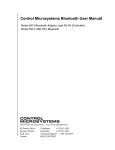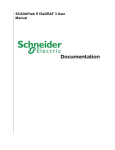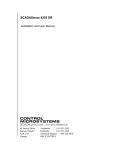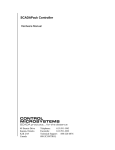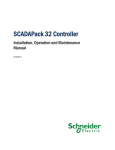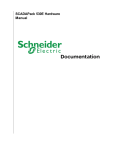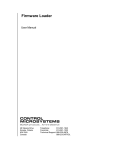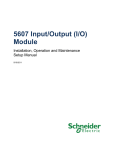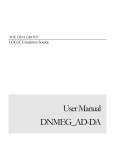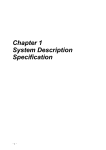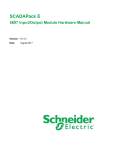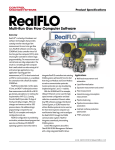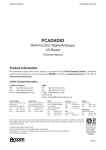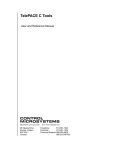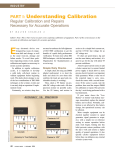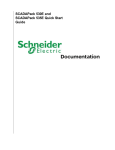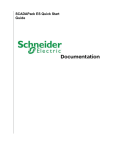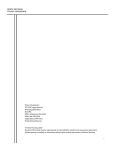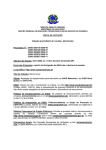Download SCADAPack 100 Controller
Transcript
SCADAPack 100 Controller Installation, Operation and Maintenance Setup Manual 5/19/2011 The information provided in this documentation contains general descriptions and/or technical characteristics of the performance of the products contained herein. This documentation is not intended as a substitute for and is not to be used for determining suitability or reliability of these products for specific user applications. It is the duty of any such user or integrator to perform the appropriate and complete risk analysis, evaluation and testing of the products with respect to the relevant specific application or use thereof. Neither Schneider Electric nor any of its affiliates or subsidiaries shall be responsible or liable for misuse of the information contained herein. If you have any suggestions for improvements or amendments or have found errors in this publication, please notify us. No part of this document may be reproduced in any form or by any means, electronic or mechanical, including photocopying, without express written permission of Schneider Electric. All pertinent state, regional, and local safety regulations must be observed when installing and using this product. For reasons of safety and to help ensure compliance with documented system data, only the manufacturer should perform repairs to components. When devices are used for applications with technical safety requirements, the relevant instructions must be followed. Failure to use Schneider Electric software or approved software with our hardware products may result in injury, harm, or improper operating results. Failure to observe this information can result in injury or equipment damage. © 2010 Schneider Electric. All rights reserved. Document (Version #.##.#) 5/19/2011 Table of Contents Safety Information .........................................................................5 About The Book .............................................................................8 At a Glance ............................................................................................................ 8 Overview .........................................................................................9 Installation ....................................................................................10 Field Wiring .......................................................................................................... 10 Power Supply ....................................................................................................... 11 System Grounding ............................................................................................... 12 Analog Inputs ....................................................................................................... 12 Digital Outputs ...................................................................................................... 14 Digital Inputs ........................................................................................................ 15 Digital I/O Connection Examples ......................................................................... 15 Counter Input ....................................................................................................... 16 Turbine Meter Counter Input ................................................................................ 16 Serial Communication .................................................................18 RS-232 Serial Communications Ports ................................................................. 18 RS-232 Wiring Examples ..................................................................................... 22 RS-232 Cables ..................................................................................................... 23 RS-485 Serial Communication Port ..................................................................... 25 RS-485 Wiring Examples ..................................................................................... 26 Operation ......................................................................................27 Operating Modes.................................................................................................. 27 Led Power Control ............................................................................................... 29 Jumpers ............................................................................................................... 29 Status LED ........................................................................................................... 29 Firmware Loading ................................................................................................ 30 Maintenance .................................................................................32 Fuses ................................................................................................................... 32 Lithium Battery ..................................................................................................... 32 Troubleshooting ..........................................................................34 Document (Version 2.24.1.84) 5/19/2011 2 Analog Inputs ....................................................................................................... 34 Digital Inputs ........................................................................................................ 34 Digital Outputs ...................................................................................................... 34 Specifications ..............................................................................35 General ................................................................................................................ 35 Controller .............................................................................................................. 35 Communications .................................................................................................. 36 Visual Indicators ................................................................................................... 36 Power Supply ....................................................................................................... 37 Analog Inputs ....................................................................................................... 37 Counter Inputs ...................................................................................................... 37 Digital Inputs/Outputs ........................................................................................... 38 Approvals and Certifications ......................................................40 Document (Version 2.24.1.84) 5/19/2011 3 Index of Figures Figure 1: SCADAPack 100 Board Layout .......................................................... 11 Figure 2: Analog Input Wiring ............................................................................ 13 Figure 3: Digital Input/Output and Counter Wiring ............................................. 15 Figure 4: Turbine Meter Counter Input ............................................................... 16 Figure 5: RS-485 Wiring .................................................................................... 26 Document (Version 2.24.1.84) 5/19/2011 4 Safety Information Read these instructions carefully, and look at the equipment to become familiar with the device before trying to install, operate, or maintain it. The following special messages may appear throughout this documentation or on the equipment to warn of potential hazards or to call attention to information that clarifies or simplifies a procedure. The addition of this symbol to a Danger or Warning safety label indicates that an electrical hazard exists, which will result in personal injury if the instructions are not followed. This is the safety alert symbol. It is used to alert you to potential personal injury hazards. Obey all safety messages that follow this symbol to avoid possible injury or death. DANGER DANGER indicates an imminently hazardous situation which, if not avoided, will result in death or serious injury. WARNING WARNING indicates a potentially hazardous situation which, if not avoided, can result in death or serious injury. CAUTION CAUTION indicates a potentially hazardous situation which, if not avoided, can result in minor or moderate. CAUTION CAUTION used without the safety alert symbol, indicates a potentially hazardous situation which, if not avoided, can result in equipment damage.. Document (Version 2.24.1.84) 5/19/2011 5 PLEASE NOTE Electrical equipment should be installed, operated, serviced, and maintained only by qualified personnel. No responsibility is assumed by Schneider Electric for any consequences arising out of the use of this material. A qualified person is one who has skills and knowledge related to the construction and operation of electrical equipment and the installation, and has received safety training to recognize and avoid the hazards involved. BEFORE YOU BEGIN Do not use this product on machinery lacking effective point-of-operation guarding. Lack of effective point-of-operation guarding on a machine can result in serious injury to the operator of that machine. CAUTION EQUIPMENT OPERATION HAZARD Verify that all installation and set up procedures have been completed. Before operational tests are performed, remove all blocks or other temporary holding means used for shipment from all component devices. Remove tools, meters, and debris from equipment. Failure to follow these instructions can result in injury or equipment damage. Follow all start-up tests recommended in the equipment documentation. Store all equipment documentation for future references. Software testing must be done in both simulated and real environments. Verify that the completed system is free from all short circuits and grounds, except those grounds installed according to local regulations (according to the National Electrical Code in the U.S.A, for instance). If high-potential voltage testing is necessary, follow recommendations in equipment documentation to prevent accidental equipment damage. Before energizing equipment: Remove tools, meters, and debris from equipment. Close the equipment enclosure door. Remove ground from incoming power lines. Perform all start-up tests recommended by the manufacturer. OPERATION AND ADJUSTMENTS The following precautions are from the NEMA Standards Publication ICS 7.11995 (English version prevails): Document (Version 2.24.1.84) 5/19/2011 6 Regardless of the care exercised in the design and manufacture of equipment or in the selection and ratings of components, there are hazards that can be encountered if such equipment is improperly operated. It is sometimes possible to misadjust the equipment and thus produce unsatisfactory or unsafe operation. Always use the manufacturer’s instructions as a guide for functional adjustments. Personnel who have access to these adjustments should be familiar with the equipment manufacturer’s instructions and the machinery used with the electrical equipment. Only those operational adjustments actually required by the operator should be accessible to the operator. Access to other controls should be restricted to prevent unauthorized changes in operating characteristics. Document (Version 2.24.1.84) 5/19/2011 7 About The Book About The Book At a Glance Document Scope This manual describes the SCADAPack 100 controller. Validity Notes This document is valid for all versions of the SCADAPack 100 controller. Product Related Information WARNING UNINTENDED EQUIPMENT OPERATION The application of this product requires expertise in the design and programming of control systems. Only persons with such expertise should be allowed to program, install, alter and apply this product. Follow all local and national safety codes and standards. Failure to follow these instructions can result in death, serious injury or equipment damage. User Comments We welcome your comments about this document. You can reach us by e-mail at [email protected]. Document (Version 2.24.1.84) 5/19/2011 8 Overview Overview The SCADAPack 100 is a small footprint controller that comes complete with an integrated power supply, analog and digital I/O, serial communications and a counter input. Application programs can be written in Telepace Relay Ladder Logic, IEC 61131-3 and the C language. As of October 2004 the SCADAPack 100 controller has been upgraded to include more memory to run larger applications and, if needed, a single gas flow computer. The versions of the SCADAPack 100 are identical in every way except for the difference in memory size. The controller type for the original version of the SCADAPack 100 is SCADAPack 100:256K. This controller type has a total of 256K CMOS nonvolatile (battery backed) RAM and will have a controller ID of A182921 or less. The controller type for the current version of SCADAPack 100 is SCADAPack 100: 1024K. This controller type has a total of 1024K CMOS non-volatile (battery backed) RAM and will have a controller ID of A182922 or newer. Document (Version 2.24.1.84) 5/19/2011 9 Installation Installation The installation of SCADAPack controllers requires mounting the SCADAPack controller on the 7.5mm by 35mm DIN rail and connecting the SCADAPack controller to the system I/O Bus. Refer to the System Configuration Guide for complete information on system layout, I/O Bus cable routing and SCADAPack controller installation. For ATEX and IECx applications only: This equipment is to be installed in an enclosure certified for use, providing a degree of protection of IP54 or better. The free internal volume of the enclosure must be dimensioned in order to keep the temperature rating. A T4 rating is acceptable. Field Wiring SCADAPack controllers use screw termination style connectors for termination of field wiring. These connectors accommodate solid or stranded wires from 12 to 22 AWG. The connectors are removable allowing replacement of the SCADAPack Controller without disturbing the field wiring. Leave enough slack in the field wiring for the connector to be removed. Remove power before servicing unit. To remove the termination connector: Pull the connector upward from the board. Apply even pressure to both ends of the connector. To install the termination connector: Line up the pins on the module with the holes in the connector. Push the connector onto the pins. Apply even pressure to both ends on the connector. There are six connectors for field wiring. Refer to Figure 1: SCADAPack 100 Board Layout for connector locations. The two RS-232 communication ports, COM1 and COM2, connect to 8 pin modular jacks. Refer to section RS-232 Serial Communications Ports for pinout details and wiring diagrams for these modular jacks. Field wiring terminates in removable terminal connectors. Connector pinouts and wiring examples are described in each of the respective sections of this manual. Document (Version 2.24.1.84) 5/19/2011 10 Installation Figure 1: SCADAPack 100 Board Layout Power Supply The SCADAPack 100 is powered from an 11VDC to 24VDC power source. Refer to section Specifications of this manual for the minimum and maximum operating voltages and actual power requirements. The SCADAPack 100 will shutdown when operating below the minimum recommended voltage. Exceeding the maximum input voltage or applying a reverse voltage will blow the input power fuse. Unlike the other members of the SCADAPack family, the SCADAPack 100 connects only to DC power sources. Connections to power sources such as 16Vac transformers will blow the fuse and may cause damage to the SCADAPack 100. The DC power input voltage generates 5V for the SCADAPack 100 circuitry and a limited amount of expansion. Refer to the SCADAPack 100 power supply specifications and the specifications of the expansion components to determine if the power supply has sufficient capacity for your application. The capacity of the 5V supply is sufficient to power the SCADAPack 100, one 5000 modem and a SCADAPack Vision operator interface. Document (Version 2.24.1.84) 5/19/2011 11 Installation System Grounding In applications, it is desirable to ground the system by connecting the system power supply common, to the chassis or panel ground. The negative (–ve) side of the DC power input terminal as well as I/O point terminals labeled GND are connected to chassis ground. Analog Inputs The controller has two internal analog inputs, used by application programs to monitor RAM voltage and controller board ambient temperature. There are four single ended analog inputs available to the user. Refer to the appropriate software manual for information on using the SCADAPack 100 Analog Inputs in application programs. For Telepace applications refer to the Register Assignment for SCADAPack 100 I/O module and for IEC 61131-1 applications refer to the I/O Complex Equipment for SCADAPack 100. Internal Analog Inputs SCADAPack 100 Controllers have two internal analog inputs. These internal analog inputs are accessed using Telepace Register Assignment module SCADAPack 100 I/O, or IEC 61131-1 I/O Connection sp100: SCADAPack100 I/O. The ambient temperature input measures the temperature at the controller circuit board. It is useful for measuring the operating environment of the controller and returns an integer value in the range –40 to 75. The temperature reading represents temperatures in the range -40°C to 75°C. Temperatures outside this range cannot be measured. To display temperatures in degrees Fahrenheit, use the Telepace AIN Controller Temperature register assignment module or IEC 61131-1 I/O Connection aintemp. The lithium battery input measures the voltage of the battery that maintains the non-volatile RAM in the controller. The reading returned from this input is in the range from 0 – 5000 representing the battery in mV. It is useful in determining if the battery needs replacement. The 3.6V lithium battery will return a typical value of 3500 to 3700. A reading less than 3000 (3.0V) indicates that the lithium battery requires replacement. I/O Analog Inputs There are four single ended analog inputs available to the user. These analog inputs use a 12-bit, successive approximation, analog to digital converter. The analog inputs have transient reduction and share a common return (GND) that is connected to the chassis. Refer to Figure 1: SCADAPack 100 Board Layout for the location of P9. The analog inputs are identified as Channel 0 through Channel 3. The first three, identified as Channels 0 through 2, use range jumpers to select either voltage inputs or current inputs. These analog inputs are single ended and measure voltages up to 5V. When configured as current inputs, the 250 current sense Document (Version 2.24.1.84) 5/19/2011 12 Installation resistor will produce at 5V input at 20mA. See Figure 1: SCADAPack 100 Board Layout for the location of the range jumpers. The fourth input, identified as Channel 3, is a 32.768V voltage input. This input is typically used to monitor the input power or battery voltage. The analog inputs support loop powered and self powered transmitters. Loop powered transmitters are two terminal devices that connect between a power supply and the analog input. The loop current continues from the power supply, through the transmitter and to ground through a 250 resistor built into the 20mA input circuit. Self-powered transmitters have three terminals called power in, signal out and common. Self-powered transmitters can have a current or voltage output. The signal out connects to the Analog Input Channel, the common connects to GND and the power in connects to a power supply. The user is to confirm the transmitter has enough voltage for proper operation. The transmitter manufacturer supplies the minimum operating voltage specification of the transmitter. The analog input requires a minimum of 5V. The 24Vdc power supplied to the SCADAPack 100 Power Input is typically used to power the transmitters. Figure 2: Analog Input Wiring shows example wiring of several transmitters. Channel 0 has a loop powered current transmitter connected to an external 24V power supply. Channel 1 has a self-powered voltage transmitter connected to an external 24V power supply. Channel 2 has a self-powered current transmitter connected to an external 24V power supply. Channel 3 is used to monitor the external 24V power supply. PWR Voltage O/P + External 24Vdc Power Supply _ COM PWR Current O/P COM + _ 4 3 2 1 GND 0 5 1 2 3 P9 - Analog Inputs 0 1 2 Current Voltage J1 J2 J3 Figure 2: Analog Input Wiring Document (Version 2.24.1.84) 5/19/2011 13 Installation Analog Input Range Jumpers Channels 0 through 2 can be user configured for either voltage or current operation with jumper links. Refer to Figure 2: Analog Input Wiring for examples of the how a jumper link is installed on J1 through J3. A jumper link installed in the Current position of the header results in a 250 resistor across the appropriate analog input. A jumper link installed in the Voltage position of the header results in high impedance analog input. Analog Input Data Format The I/O analog inputs have a 12-bit, unipolar, analog to digital (A/D) converter that measures input voltages from 0 to 5V. A/D converter data is scaled and filtered by a microcontroller and is represented with a 15 bit unsigned number. The following table shows the A/D output value for several input signals. Current Channel 0-2 Voltage Channel 0-2 Voltage Channel 3 A/D Output 0mA 4.88uA 4mA 10mA 19.990mA 19.995mA 20mA 0V 1.22mV 1.0V 2.5V 4.9975V 4.999V 5.0V 0V 0.008V 6.554V 16.384V 32.752V 32.760V 32.768V 0 8 6554 16384 32752 32760 32760 Digital Outputs The SCADAPack 100 provides six universal digital inputs or outputs. Outputs are open-collector/open drain type for use with sustained DC loads up to 1 ampere. The negative side of the load is connected to the desired terminal on the controller terminal block P3. The positive side of the load connects to a power supply. When the load is on the load current is switched through the controller to terminal labeled GND. GND is to be connected to the negative side of the power supply. Inductive load transient suppression is built into each digital output point. It is not necessary to add additional inductive load transient suppression unless highly inductive loads (greater than 1H) are operated continuously at greater than 0.5Hz. Refer to the appropriate software manual for information on using the SCADAPack 100 Digital Inputs and Outputs in application programs. For Telepace applications refer to the Register Assignment for SCADAPack 100 I/O module and for IEC 61131-1 applications refer to the I/O Complex Equipment for SCADAPack 100 I/O. Document (Version 2.24.1.84) 5/19/2011 14 Installation Digital Inputs The SCADAPack 100 provides six universal digital inputs and outputs. The inputs are for use with dry contacts such as switches and relay contacts. The SCADAPack 100 provides the wetting current for the contacts. If LED power is enabled, the SCADAPack 100 continuously sources approximately 5mA wetting current into each dry contact input. Indicator LEDs will be at their maximum brilliance if on. This facilitates field service and diagnostics. If LED power is disabled then the wetting current is turned on only when the digital inputs are scanned by the SCADAPack 100. Power consumption is reduced as the inputs are scanned only once every millisecond. Indicator LEDs are dim in this condition. This is normal. Refer to the appropriate software manual for information on using the SCADAPack 100 Digital Inputs and Outputs in application programs. For Telepace applications refer to the Register Assignment for SCADAPack 100 I/O module and for IEC 61131-1 applications refer to the I/O Complex Equipment for SCADAPack 100 I/O. Digital I/O Connection Examples Various I/O point wiring examples are shown in Figure 3: Digital Input/Output and Counter Wiring. Digital I/O point 0 is shown connected to a 24V load that uses the same 24V power supply that powers the SCADAPack 100. Digital I/O point 2 is shown monitoring a dry contact. Digital I/O point 5 is shown monitoring an open collector contact. Transient voltage suppression is included on each I/O point. Dry contact input. Internal turbine meter amplifier. J9 J11 P3 – DC Power In, Digital I/O, RS-485 COM1 + 24Vdc Power Supply _ + – 0 1 2 3 4 5 CTR GND 1 2 4 5 6 7 8 3 9 10 A B 11 12 + 24V Load – Figure 3: Digital Input/Output and Counter Wiring Document (Version 2.24.1.84) 5/19/2011 15 Installation Counter Input The Counter described in this manual applies to the SCADAPack 100 version 4 PCB. If you require a description of earlier versions please contact Control Microsystems Technical Support. The SCADAPack 100 has one counter input identified as CTR. This counter can be configured for use with open collector/drain output amplifiers, dry contacts or a direct connection to a turbine meter sensor. The maximum number of counts is 4,294,967,295. The counter rolls over to 0 when the maximum count is exceeded. The count value is stored in two userdefined registers. Refer to the appropriate software manual for information on using the SCADAPack 100 Counter Inputs in application programs. For Telepace applications refer to the Register Assignment for SCADAPack 100 I/O module and for IEC 61131-1 applications refer to the I/O Complex Equipment for SCADAPack 100 I/O. Dry contact input. Internal turbine meter amplifier. J9 J11 P3 – Power, DIO, Counter and RS-485 CTR 1 2 3 4 5 6 7 8 9 GND 10 11 12 Turbine Meter Sensor Figure 4: Turbine Meter Counter Input Turbine Meter Counter Input The SCADAPack 100 allows for the direct connection of a turbine meter sensor. These sensors produce millivolt outputs and when used with the SCADAPack 100 an external pre-amplifier is not required. The turbine meter inputs should be used in low noise environments with shielded cabling. There are two jumper links associated with configuring the inputs for either millivolt signals (direct to sensor) or high-level signals such as external amplifiers, dry contacts or open collector outputs. Refer to Figure 4: Turbine Meter Counter Input for an example of how to configure the jumper links and wire the Document (Version 2.24.1.84) 5/19/2011 16 Installation inputs. The counter is shown as a millivolt input with a direct connection to a turbine meter sensor. J 9 and J11 are in the internal turbine meter amplifier or top positions. The use of shielded wiring and that the shield is connected at one end only. When connecting to a turbine meter amplifier the manufacturer may have a specific current requirement to power the pre-amplifier. The SCADAPack 100 does not include the necessary resistor for this application. J11 jumper would be removed. Wire the amplifier as per the manufacturers recommendations with an external resistor. The counter can be used with conventional sources such as open collector transistors and contacts. The SCADAPack 100 includes a 4700-ohm resistor from the counter input to the DC input power source. This resistor can be used when the SCADAPack 100 is powered from 12 or 24V. Both J9 and J11 would be in the Dry Contact or top positions. A wiring example showing an open collector transistor is shown in Figure 3: Digital Input/Output and Counter Wiring. Example jumper settings are shown below. J9. Turbine meter sensor uses internal amplifier. J11. Turbine meter sensor uses internal amplifier. J9. Open collector, dry contact or turbine meter with external amplifier. J11. Open collector or dry contact. Internal pullup resistor is used. J11. Open collector, dry contact or turbine meter with external amplifier. User must supply external resistor from input to suitable power source. Document (Version 2.24.1.84) 5/19/2011 17 Serial Communication Serial Communication The SCADAPack 100 controller is equipped with two serial communication ports. One serial communication port support RS-232 serial communication and the other serial port supports either RS-232 or RS-485 serial communication. Serial ports on the SCADAPack 100 controller are designated COM1 and COM2. Refer to Figure 1: SCADAPack 100 Board Layout for the location of the serial ports. RS-232 Serial Communications Ports The two RS-232 serial ports are designated COM1 and COM2. COM1 can be used as RS-232 or RS-485 but not both standards at the same time. COM1 RS-232 Serial Port Serial port COM1 on the SCADAPack 100 controller is configured as a two wire RS-485 serial communication port and a RS-232 serial communication port. The port can be used for either standard at one time. The following table shows the serial and protocol communication parameters supported by COM1. These parameters are set from Telepace, IEC 61131-1 or from an application program running in the SCADAPack 100 controller. Default values are set when a Cold Boot or Service Boot is performed on the SCADAPack 100 controller. Parameter Supported Values Baud Rate 300, 600, 1200, 2400, 4800, 9600, 19200 and 38400 Default: 9600 Full or Half Default: Full Odd, None or Even Default: None 7 or 8 Bits Default: 8 Bits 1 or 2 Bits Default: 1 Bit ModbusRTU or None Default: ModbusRTU Ignore CTS or None Default: None 1 to 65534 Default: 1 Duplex Parity Data Bits Stop Bits Receive Flow Control Transmit Flow Control Station Document (Version 2.24.1.84) 5/19/2011 18 Serial Communication Parameter Supported Values Protocol None, Modbus RTU or Modbus ASCII Default: Modbus RTU Standard or Extended Default: Standard Addressing Mode Connections to COM1 are made through a RJ-45 modular connector. COM1 supports RxD and TxD plus Ground and 5V power. The following diagram shows the pin connections for the RS-232 (RJ-45) port connector for COM1. RJ-45 Modular Jack 1 2 3 4 5 6 7 8 1. 2. 3. 4. 5. 6. 7. 8. +5V NC NC GND RxD TxD NC NC NOTES: +5V is only available on Pin 1 when a jumper is installed on J5. Refer to the Figure 1: SCADAPack 100 Board Layout for the location of J5. The low power transmitters used in COM1 transmit 0 to 5V levels. This is less than the RS-232 specification but still compatible with RS-232 receivers. Cables should be limited to a maximum of 10 ft (3m). The following table provides a description of the function of each pin of the RJ-45 connector. In this table a MARK level is a voltage of +3V or greater and a SPACE level is a voltage of 0V. Pin Function Description 1 5V (Output) NC NC GND RxD (Input) This pin can be connected to the 5V power supply by installing a jumper at J5. No connection. No connection. This pin is connected to the system ground. The level is SPACE on standby and MARK for received data. The LED is lit for a MARK level. The level is SPACE on standby and MARK for transmitted data. 2 3 4 5 6 TxD (Output) Document (Version 2.24.1.84) 5/19/2011 19 Serial Communication Pin 7 8 Function Description NC NC The LED is lit for a MARK level. No connection. No connection. COM2 RS-232 Serial Port The following table shows the serial and protocol communication parameters supported by COM2. These parameters are set from Telepace, IEC 61131-1 or from an application program running in the SCADAPack 32 controller. Default values are set when a Cold Boot or Service Boot is performed on the SCADAPack 32 controller. Parameter Supported Values Baud Rate 300, 600, 1200, 2400, 4800, 9600, 19200 and 38400 Default: 9600 Full or Half Default: Full Odd, None or Even Default: None 7 or 8 Bits Default: 8 Bits 1 or 2 Bits Default: 1 Bit ModbusRTU or None Default: ModbusRTU Ignore CTS or None Default: None 1 to 65534 Default: 1 None, Modbus RTU or Modbus ASCII Default: Modbus RTU Standard or Extended Default: Standard Duplex Parity Data Bits Stop Bits Receive Flow Control Transmit Flow Control Station Protocol Addressing Mode Connections to COM2 are made through a RJ-45 modular connector. COM2 supports six signals plus Ground and 5V power. The following diagram shows the pin connections for the RS-232 (RJ-45) port connector for COM2. Document (Version 2.24.1.84) 5/19/2011 20 Serial Communication RJ-45 Modular Jack 1 2 3 4 5 6 7 8 1. 2. 3. 4. 5. 6. 7. 8. +5V DCD DTR GND RxD TxD CTS RTS NOTES: +5V is only available on Pin 1 when a jumper is installed on J6. Refer to the Figure 1: SCADAPack 100 Board Layout for the location of J6. The low power transmitters used in COM2 transmit 0 to 5V levels. This is less than the RS-232 specification but still compatible with RS-232 receivers. Cables should be limited to a maximum of 10 ft (3m). The following table provides a description of the function of each pin of the RJ-45 connector. In this table a MARK level is a voltage of +3V or greater and a SPACE level is a voltage of 0V. Pin Function Description 1 5V (Output) DCD (Input) DTR (Output) This pin can be connected to the 5V power supply by installing a jumper at J6. The DCD led is on for a MARK level. 2 3 4 5 GND RxD (Input) 6 TxD (Output) 7 CTS (Input) 8 RTS Document (Version 2.24.1.84) 5/19/2011 This pin is normally at a MARK level. This pin is at a SPACE level when DTR is de-asserted. This pin is connected to the system ground. The level is SPACE on standby and MARK for received data. The LED is lit for a MARK level. The level is SPACE on standby and MARK for transmitted data. The LED is lit for a MARK level. This level is a MARK for the communication port to transmit data. When the attached device does not provide this signal, the controller keeps the line at a MARK. When the attached device does provide this signal, it sets the CTS to MARK to allow the controller to transmit data. This pin is a MARK if full-duplex operation is selected for 21 Serial Communication Pin Function Description (Output) the port. This pin is set to a MARK just before and during transmission of data if half-duplex operation is selected. This pin is set to a SPACE when no data is being transmitted. The LED is ON for a MARK level. RS-232 Wiring Examples DTE to DTE without Handshaking There are several methods for wiring the RS-232 COM port to DTE (Data Terminal Equipment) and DCE (Data Communications Equipment) devices. The simplest connection requires only 3 wires: RxD, TxD and signal ground. The following diagram shows a common RS-232 COM port to DTE device. RS-232 COM port (DTE) 8 Pin connector DTE DCD 2 DCD RxD 5 RxD TxD 6 TxD DTR 3 DTR GND 4 GND RTS 8 CTS 7 RTS + 5V 1 CTS See device specifications for pin numbers DTE to DTE with Handshaking Some DTE devices may require hardware handshaking lines. Common hardware handshaking lines are the CTS and RTS lines. Less common are the DTR and DCD lines. The controller does not require these lines. Refer to the specifications of the external device for exact requirements. The following diagram shows a common connection of an RS-232 COM port with a DTE device requiring handshaking lines. Document (Version 2.24.1.84) 5/19/2011 22 Serial Communication RS-232 COM port (DTE) 8 Pin connector DTE DCD 2 DCD RxD 5 RxD TxD 6 TxD DTR 3 DTR GND 4 GND RTS 8 CTS 7 RTS + 5V 1 CTS See device specifications for pin numbers DTE to DCE with Handshaking DCE devices require different wiring with the handshaking lines connected in cases. Many DCE devices are half duplex. Select half-duplex operation with these devices. The diagram below shows common connection of a SCADAPack with a DCE device requiring handshaking lines. RS-232 COM port (DTE) 8 Pin connector DCE DCD 2 DCD RxD 5 RxD TxD 6 TxD DTR 3 DTR GND 4 GND RTS 8 RTS CTS 7 CTS + 5V 1 See device specifications for pin numbers RS-232 Cables RJ-45 to DE-9S DTE This cable is used to connect from an RJ-45 based RS-232 port on the SCADAPack controller to DE-9P connector on a DTE such as a PC. A 10 ft. long cable is available from Control Microsystems as part number TBUM297217. Document (Version 2.24.1.84) 5/19/2011 23 Serial Communication RJ-45 8 Pins SCADAPack DTE Function 6 5 4 1, 2, 3, 7 and 8 are not connected at this end. TxD RxD GND DE9S DTE Function DE9S Shield connects to shell 2 3 5 Wires not connected at this end. RxD TxD GND RJ-45 to SCADAPack Vision This cable is used to connect from an RJ-45 based RS-232 port on the SCADAPack 100 controller to DE-9P connector on a SCADAPack Vision. A 5 ft. long cable is available from Control Microsystems as part number TBUM297237. The SCADAPack 100 does not implement the Vision ON Switch power up feature. RJ-45 8 Pins 6 5 4 3 2 1 7 and 8 are not connected at this end. SCADAPack 100 Function TxD RxD GND NC NC +5V Out SCADAPack Vision Function RxD TxD GND ON switch ON switch +5V In DE9S Shield connects to shell 2 3 5 1 4 9 Wires not connected at this end. RJ-45 to DE-9P DCE This cable is used to connect from an RJ-45 based RS-232 port on the SCADAPack controller to DE-9S connector on a DCE such as a modem. A 15inch long cable is available from Control Microsystems as part number TBUM297218. RJ45 SCADAPack DTE Function DE-9P DCE Function DE-9P Shield connects to shell Document (Version 2.24.1.84) 5/19/2011 24 Serial Communication 3 6 5 2 4 7 8 1 DTR TxD RxD DCD GND CTS RTS +5V DTR TxD RxD DCD GND CTS RTS +5V 4 3 2 1 5 8 7 9 RS-485 Serial Communication Port Serial port COM1 on the SCADAPack 100 controller is configured as a two wire RS-485 serial communication port and a RS-232 serial communication port. The port can be used for either standard at one time. COM1 transmits and receives differential voltages to other RS-485 devices on a network. The RS-485 specification allows a maximum of 32 devices connected on a single RS-485 network. The specification for RS-485 recommends that the cable length should not exceed a maximum of 4000 feet or 1200 meters. Termination resistors are required when using long cable lengths and high baud rates. Refer to section RS-485 Termination Resistors for information on termination resistors. The signal grounds of the RS-485 devices in the network are not connected together but instead are referenced to their respective incoming electrical grounds. Wire the ground connections of the RS-485 devices on the network to be within several volts of each other. RS-485 Bias Resistors The RS-485 receiver inputs on the SCADAPack 100 controller are biased such that that received data is driven to a valid state (space) when there are no active drivers on the network. The value of these bias resistors is 5100 ohms from Ground to the B input and 5100 ohms from +5V to the A input. RS-485 Termination Resistors Termination resistors are required in long networks operating at the highest baud rates. Shorter networks in high noise environments may also benefit from terminations. Networks as long as 1000 ft. operating at 9600 baud will function without termination resistors. Terminations should be considered if the baud rate is higher and the network is longer. When termination resistors are required, they are installed on the first and last station on the RS-485 wire pair. Other stations should not have termination resistors. RS-485 networks are generally terminated with 120-ohm resistors on each end. The required 120-ohm resistor is supplied and installed by the user. When using termination resistors it is necessary to increase the line biasing by adding lower value bias resistors in order to generate at least 0.2V across RS-485 line. The Document (Version 2.24.1.84) 5/19/2011 25 Serial Communication suggested value of the bias resistors is 470 ohms. One bias resistor is installed from P3 terminal 12 (B) to P3 terminal 2 or 10 (COM). The second bias resistor is installed from P3 terminal 11 (A) to +5V. +5V is available on P7 pin 1 when J8 is installed. Consult Control Microsystems Tech Support for application assistance. RS-485 Wiring Examples A typical RS-485 wiring example is shown below. COM1 is shown connected to a multivariable transmitter such as the Rosemount 3095. The power for the transmitter comes from the SCADAPack 100 power input. P3 – DC Power In, Digital I/O, RS-485 + – 1 2 3 4 5 6 7 8 9 10 A B 11 12 + PWR + 24Vdc Power Supply _ A B – PWR Figure 5: RS-485 Wiring Document (Version 2.24.1.84) 5/19/2011 26 Operation Operation Operating Modes SCADAPack 100 Controllers may start up in RUN, SERVICE or COLD BOOT mode. Start up in the RUN mode automatically executes Telepace Ladder Logic and Telepace C programs in the controller memory. Start up in the SERVICE mode stops the programs to allow reprogramming and controller initialization. Start up in the COLD BOOT mode initializes the controller and erases application programs. Run Mode The RUN mode is the normal operating mode of the SCADAPack 100 Controller. No action is required to select RUN mode. When power is applied to the controller board: The user defined serial communication parameters for COM ports are used. If a Telepace Ladder Logic application program is loaded in RAM, it is executed. If a Telepace C application program is loaded in RAM and the program checksum is correct, it is executed. If there is no application program in RAM and there is an application program in flash ROM then the flash ROM program will be executed. The controller lock settings and password are used. Service Mode SERVICE mode is used during application programming and maintenance work. When the SCADAPack 100 controller starts in SERVICE mode: The default serial communication parameters are used (see the Telepace Ladder Logic User Manual or the Telepace C Tools User Manual for a description of the default parameters). The Ladder Logic program is stopped. The C program is stopped. Application programs are retained in non-volatile memory. The controller lock settings and password are used. SERVICE mode is selected by performing a SERVICE BOOT using the following procedure: Remove power from the SCADAPack 100 controller. Document (Version 2.24.1.84) 5/19/2011 27 Operation Hold down the LED POWER button. Apply power to the controller. Continue holding the LED POWER button until the STAT LED turns on. Release the LED POWER button. If the LED POWER button is released before the STAT LED turns on, the SCADAPack 100 controller will start in RUN mode. Cold Boot Mode COLD BOOT mode is used after installing new controller firmware. When the SCADAPack 100 controller starts in COLD BOOT mode: The default serial communication parameters are used (see the Telepace Ladder Logic User Manual or the Telepace C Tools User Manual for a description of the default parameters). The Ladder Logic program is erased. The C program is erased. The registers in the I/O database are initialized to their default values. The Register Assignment is erased. The controller is unlocked. COLD BOOT mode is selected by performing a COLD BOOT using the following procedure: Remove power from the SCADAPack controller. Hold down the LED POWER button. Apply power to the SCADAPack controller. Continue holding the LED POWER button for 25 seconds until the STAT LED begins to flash on and off continuously. Release the LED POWER button. If the LED POWER button is released before the STAT LED begins to flash, the SCADAPack controller will start in SERVICE mode. LED Indicators There are 17 LEDs on SCADAPack 100. LEDs can be disabled to conserve power. The table below describes the LEDs. LED Function Power Mode On when operating and the LEDs are enabled. Blinks once per second when the LEDs are disabled. On when the ladder logic program is executing. The LED will blink when an unwanted controller condition exists. RUN STAT Document (Version 2.24.1.84) 5/19/2011 28 Operation LED Function FORCE RX TX CTS DCD Digital I/O On when I/O points are forced. On when receiving data on the corresponding serial port. On when transmitting data on the corresponding serial port. On when the CTS input is asserted COM2. On when the DCD input is asserted COM2. On when the corresponding I/O point is on. LEDs are dim when LEDs are disabled when the corresponding I/O point is on. On when the counter input is present and low. CTR Led Power Control The SCADAPack 100 controller board can disable the LEDs on the controller to conserve power. This is particularly useful in solar powered or unattended installations. The Power Mode LED on the controller board indicates the LED power state. It is on when the controller board enables LED power. The LED POWER push-button toggles the LED power signal. Press the LED POWER push-button to toggle LED power from off to on, or from on to off. The application program sets the default state of the power. The LED power returns to the default state 5 minutes after the LED POWER push-button is last pressed. The application program may change the default time and state. Jumpers Headers on the SCADAPack 100 are user configurable and are described in the appropriate sections of this manual. Some headers and jumpers on the SCADAPack 100 are reserved for manufacturing and test functions. Refer to Figure 1: SCADAPack 100 Board Layout for the location of jumpers. The following table lists the jumpers and the relevant section of this manual. Jumper Function J1 J2 J3 J5 J6 Analog Input 0 Range Analog Input 1 Range Analog Input 2 Range COM1 5 Volts on Pin 1 COM2 5 Volts on Pin 1 Figure 2: Analog Input Wiring Figure 2: Analog Input Wiring Figure 2: Analog Input Wiring COM1 RS-232 Serial Port COM2 RS-232 Serial Port Status LED The status LED labeled STAT on the controller board indicates a controller condition that needs to be addressed. The STAT LED blinks and the STATUS output opens when such a condition occurs. The STATUS output remains open continuously when a controller condition is present. The STAT LED turns off and the STATUS output closes when the condition clears. Document (Version 2.24.1.84) 5/19/2011 29 Operation The STAT LED is on continuously during reset. The STAT LED blinks a binary sequence indicating condition codes. The sequences consist of long and short flashes, followed by an off delay of 1 second. The sequence then repeats. The sequence may be read as the Controller Status Code. A short flash indicates a binary zero. A long flash indicates a binary one. The least significant bit is output first. As few bits as possible are displayed, leading zeros are ignored. The application program defines the values of the condition codes. The table below shows the meaning of the sequences. Sequence CONTROLLER STATUS CODE Off 1 Long 1 Short, 1 Long 0 = Normal I/O Module Indication Register Assignment Checksum Indication. I/O Module Indication When the Status LED flashes the controller status code 1 (i.e. a long flash, once every second), one or more I/O module is not communicating with the controller. To correct do one of the following: Check that every module contained in the Register Assignment Table is connected to the controller. Check that the module address selected for each module agrees with the selection made in the Register Assignment Table. If a module is still suspect confirm the condition by removing the module from the Register Assignment Table. Write the changes to the controller. The Status LED should stop flashing. If a module is currently not connected to the controller, delete it from the Register Assignment Table. Write the changes to the controller. The Status LED should stop flashing. If unused modules are intentionally left in the Register Assignment Table, the I/O indication may be disabled from a selection box on the Register Assignment dialog. Register Assignment Checksum Indication When the status LED flashes the controller status code 2 (i.e. a short flash then a long flash followed by a 1 second of delay), this indicates the register assignment is not valid. To correct this, initialize the register assignment from the Telepace software, or alternatively, perform a COLD BOOT as described in section Cold Boot Mode of this manual. The status LED should stop flashing. Firmware Loading Periodically the firmware for a controller is updated to add new features or provide bug fixes. As they become available new firmware versions may be downloaded from www.controlmicrosystems.com. Document (Version 2.24.1.84) 5/19/2011 30 Operation Allowed connections for firmware loading for a SCADAPack 100 controller are Com1 or com2 serial ports. Document (Version 2.24.1.84) 5/19/2011 31 Maintenance Maintenance The SCADAPack 100 controller requires little maintenance. The Power Mode LED indicates the status of the 5V supply. If the LED is off the on board fuse F1 may require replacing. If the program is lost during power outages, the lithium battery may require replacement. The analog input and output circuitry is calibrated at the factory and does not require periodic calibration. Calibration may be necessary if the module has been repaired as a result of damage. If the SCADAPack 100 Controller is not functioning correctly, contact Control Microsystems Technical Support for information on returning the SCADAPack Controller for repair. WARNING Remove power or confirm the area is known to be non-hazardous before changing field wiring, including the wiring to the RS-232 ports. Failure to follow these instructions can result in death, serious injury or equipment damage. Fuses A single 0.375 Amp fast-blow fuse protects the power supply. The fuse is mounted under the cover. Refer to Figure 1: SCADAPack 100 Board Layout for the location. Remove power before servicing unit. Replace a blown fuse with a fuse of the same rating. Under no circumstances should a fuse be bypassed or replaced with a fuse of a higher rating. The fuse is a Littelfuse Nano-SMF. Littelfuse part number LF R451.375. These fuses are available from Control Microsystems. Investigate and correct the cause of the blown fuse before replacement. Common causes of blown fuses are wiring and excessive input voltages. Lithium Battery A small lithium battery powers the CMOS memory and real-time clock when input power is removed. The voltage of a functioning battery should be greater than 3.0V. An application program can monitor this voltage. Refer to the programming manual for details. The battery should not require replacement under normal conditions. The shelf life of the battery is 10 years. The battery is rated to maintain the real-time clock Document (Version 2.24.1.84) 5/19/2011 32 Maintenance and RAM data for two years with the power off. Accidental shorting or extreme temperatures may damage the battery. Battery Replacement Procedure The battery is plugged into the circuit board and held in place with a tie-wrap. If necessary it can be replaced with an identical battery available from Control Microsystems. Save the existing program running in the SCADAPack, if applicable. Remove power from the SCADAPack. Remove the SCADAPack top cover and locate the battery. It is found at the far right side of the circuit board. The battery tie wrapped in place at the factory. This is to keep the battery from becoming disconnected during shipment. Remove the tie wrap using wire cutters. Remove the battery by gently lifting it straight up from the circuit board. The battery has two pins that mate with two sockets on the circuit board. Replace the battery. A replacement tie wrap is not necessary. Cold boot the controller. (Refer to section in Cold Boot Mode of this manual for the Cold Boot procedure.) If a cold boot is not done the behavior of the controller is unpredictable. The controller may now be programmed. Document (Version 2.24.1.84) 5/19/2011 33 Troubleshooting Troubleshooting Analog Inputs Condition Action 20mA inputs constantly read 0. Reading is at or near 0 for input signals. 20mA readings are not accurate. Check transmitter power. Check if the input transient suppressers are damaged. Reading is constant. Check for a damaged 250 current sense resistor. Check that the analog input is not forced. Condition Action Input is on when no signal is applied. The LED is off. Input is off when a signal is applied. The LED is on. Input is on when no signal is applied. The LED is on. LED is dim. Check that the digital inputs are not forced on. Condition Action Output LED comes on and output is on, but the field device is not activated. Output LED and output are on when they should be off. Output LED and output are off when they should be on. LED is dim. Check the field wiring. Check the external device. Digital Inputs Check that the digital inputs are not forced off. Check that the digital output at that point is off. This is normal when the input is on and the LED Power is disabled. Digital Outputs Document (Version 2.24.1.84) 5/19/2011 Check that the output is not forced on. Check that the output is not forced off. This is normal when the output is on and the LED Power is disabled. 34 Specifications Specifications Disclaimer: Control Microsystems reserves the right to change product specifications. For more information visit www.controlmicrosystems.com . General I/O Terminations Dimensions Packaging Environment 5 and 12 pole, removable terminal blocks. 12 to 22 AWG 15A contacts Screw termination - 6 lb.-in. (0.68 Nm) torque 5.65 inch (144mm) wide 5.00 inch (127 mm) high 1.80 inch (45mm) deep corrosion resistant zinc plated steel with black enamel paint 5% RH to 95% RH, non-condensing o o –40 C to 70 C o o –40 F to 158 F Controller Processors Memory Non-volatile RAM Clock calendar 16-bit CMOS microcontroller, 14.74MHz clock, integrated watchdog timer microcontroller co-processor, 14.74MHz clock 256KBytes CMOS RAM (controller ID number A182921 or less) 1024KBytes CMOS RAM (controller ID number A182922 or greater) 512kBytes flash ROM 1kBytes EEPROM CMOS RAM with lithium battery retains contents for 2 years with no power 1 minute/month at 25°C +1/–3 minutes/month 0 to 50°C Internal temperature Measurement range -40°C to 75°C. Accuracy 5°C. Measurement range -40°F to 167°F. Accuracy 9°F. Lithium battery monitor Accuracy 0.2V. Document (Version 2.24.1.84) 5/19/2011 35 Specifications Communications Communication Port COM1 Communication Port COM1 Communication Port COM2 Baud Rates (COM1, COM2) Parity Word Length Stop Bits Transient Protection Isolation Cable Length Protocol Protocol Modes RS-485 serial port 2 pole removable terminal block 2 wire half duplex Bias resistors installed. RS-232 compatible serial port (CMOS) Data Terminal Equipment (DTE) 8 pin modular jack Full or half duplex Implemented Td, Rd, +5V RS-232 compatible serial port (CMOS) Data Terminal Equipment (DTE) 8 pin modular jack Full or half duplex with RTS/CTS control Implemented Td, Rd, CTS, RTS, DCD, DTR, +5V 300, 600, 1200, 2400, 4800, 9600, 19200, 38400 none, even, or odd 7 or 8 bits 1 or 2 bits COM1, COM2: 2.5kV surge withstand capability as per ANSI/IEEE C37.90.1-1989 Common ground return connected to Chassis Ground. RS-232 –maximum 10 ft (3 m) RS-485 –maximum 4000 ft (1200 m) TeleBUS (compatible with Modbus RTU and Modbus ASCII) Slave, master, master/slave, store and forward Visual Indicators COM1 COM2 Status Digital Inputs / Outputs Document (Version 2.24.1.84) 5/19/2011 received data (RxD) LED transmitted data (TxD) LED received data (RxD) LED transmitted data (TxD) LED clear to send (CTS) LED data carrier detect (DCD) LED Status LED (shows functional status) Power Mode LED Run LED Forced I/O LED 6 LEDs 36 Specifications Counters Push-button 1 LED LED power toggle Power Supply DC power Input Output capacity Efficiency 30V maximum 10.0 to 11.5V turn on 9.5V typical turn off UL508 rated 13.75-28Vdc. Class 2. Less than 500mW (at 12V) LEDs off. 2.9W maximum. 5V at 0.425A capacity 5V at 0.060A required by 5208 controller 5V at 0.365A available on COM1 and COM2 75%, 12Vdc input, full load Analog Inputs Input Points Resolution Input Resistance Converter type Accuracy Type Normal mode rejection Over-scale Input Capacity (without damage) Isolation Response Time 3 at 5V/20mA: 250 resistance user configurable with jumper link. 1 at 32.768V 12 bits over the 5V and 32.768V measurement range. 100k for 5V inputs 66k for 32.768V inputs 250 for 20mA inputs 12 bit successive approximation o ±0.1% of full scale at 25 C (77ºF) ±0.2% over temperature range single ended 27dB at 60 Hz. 5V/20mA inputs clamped at 17V. Transient: 2.5kV surge withstand capability as per ANSI/IEEE C37.90.1-1989 Analog common side connected to Chassis Ground. 100ms typical for 10% to 90% signal change Counter Inputs Digital Input Counter Document (Version 2.24.1.84) 5/19/2011 Maximum frequency 5kHz. Dry contact input. Wetting current typically 5mA with 24V input power. 37 Specifications Turbine Meter Counter Input Turbine Meter Sensitivity Dry Contact Input Thresholds Isolation Contact closure to ground is ON. Open input is OFF. Jumper link selectable for use with dry contact or open collector outputs. Designed for use with low voltage, turbine meter outputs. Jumper link selectable for use with turbine meter sensors and amplifiers. Minimum input 30mVp-p at 5-50Hz. Minimum input 150mVp-p at 150Hz. Minimum input 650mVp-p at 5kHz. Minimum input 750mVp-p at 10kHz. Maximum input 4Vp-p using internal amplifier. Maximum input 10Vp-p without internal amplifier. 0.9V typical turn on input voltage. Less than 0.4V turn on input voltage. 1.5V typical turn off input voltage. Greater than 2.2V turn off input voltage. Common ground return connected to Chassis Ground. Digital Inputs/Outputs I/O points Output Rating Input Rating Digital Input Thresholds Contact Resistance Transient Protection Document (Version 2.24.1.84) 5/19/2011 6 points Each point is an input and an output 1.0A maximum 0.35V maximum drop at 1.0A 0.05V maximum drop at 0.1A Open drain sinking when ON. 28V maximum when OFF. Dry contact input. Wetting current typically 5mA, Pulsed. Contact closure to ground is ON. Open input is OFF. 0.9V typical turn on input voltage. Less than 0.4V turn on input voltage. 1.5V typical turn off input voltage. Greater than 2.2V turn off input voltage. ON input requires less than 100Ω contact resistance. OFF input requires greater than 50kΩ contact resistance. Cable contact capacitance not to exceed 0.033uF, typically 1600ft (500m). 2.5kV surge withstand capability as per ANSI/IEEE C37.90.1-1989 38 Specifications Isolation Document (Version 2.24.1.84) 5/19/2011 Common ground return connected to Chassis Ground. 39 Approvals and Certifications Approvals and Certifications Hazardous Locations North America Hazardous Locations ATEX and IECEx Applications only Safety Digital Emissions Immunity Declaration Document (Version 2.24.1.84) 5/19/2011 Suitable for use in Class I, Division 2, Groups A, B, C and D Hazardous Locations. Temperature Code T4 per CSA Std C22.2 No. 213-M1987 / UL1604 UL listed and CSA certified to the following standards: CSA Std. C22.2 No. 213-M1987 - Hazardous Locations. UL Std. No. 1604 - Hazardous (Classified) Locations. ATEX II 3G, Ex nA IIC T4 per EN 60079-15, protection type n (Zone 2) Does not include Wireless versions. This equipment is to be installed in an enclosure certified for use, providing a degree of protection of IP54 or better. The free internal volume of the enclosure must be dimensioned in order to keep the temperature rating. A T4 rating is acceptable. For products using Solid State Relays (5415, 5606 and 5607 modules and SCADAPack using 5606 and 5607 modules) A T4 rating is acceptable for maximum loads of 2A. When 3A loads are connected to the Solid State Relays, the maximum ambient rating is lowered to 50°C in order to maintain the T4 rating. CSA (cCSAus) certified to the requirements of: CSA C22.2 No. 142-M1987 and UL508. (Process Control Equipment, Industrial Control Equipment) UL (cULus) listed: UL508 (Industrial Control Equipment) FCC Part 15, Subpart B, Class A Verification EN50081-2: Electromagnetic Compatibility Generic Emission Standard Part2: Industrial Environment C-Tick compliance. Registration number N15744. EN61000-6-2: Electromagnetic Compatibility Generic Standards Immunity for Industrial Environments This product conforms to the above Emissions and Immunity Standards and therefore conforms with the requirements of Council Directive 2004/108/EEC (as amended) relating to electromagnetic compatibility and is eligible to bear the CE mark. The Low Voltage Directive is not applicable to this product. 40 Approvals and Certifications Document (Version 2.24.1.84) 5/19/2011 41










































